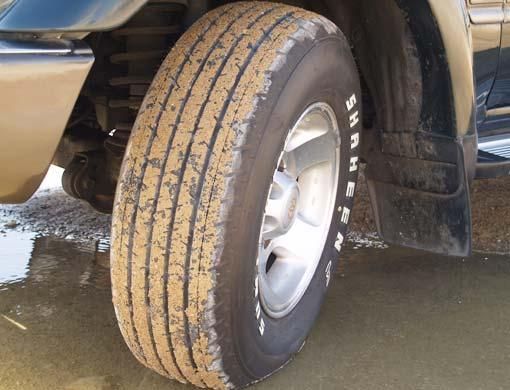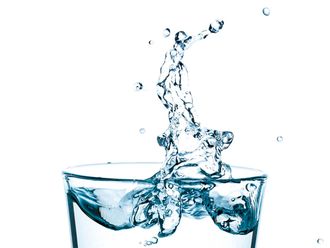Paolo Rossetti never tires of looking for the right tyres - be they for off-road or urban travel. He details how he chooses the right one and is happy as a result of it!
Following my review of the Interco TrXus tyres last year, which I felt were the best off-roading tyres I could find for UAE conditions, I have continued my search for a less hardcore tyre, one that is more inclined towards a "softer" application of urban travel in addition to sand driving.
Some of you may remember the strong reservations I voiced against dedicated sand tyres, simply because they are not designed nor marketed as appropriate for highway use.
I feel that as effective as they are in the precise condition they were designed and tested for, they are incredibly dangerous when used in different conditions.
The popular sand tyres often seen on large SUVs on our roads have the tread run parallel to the tyre, offering very little road traction.
Also, the sidewalls are as soft as possible and many well-known brands run without steel belts to keep the weight down. These are perfect on the sand where a "balloon" tyre needs to spin over sand without biting or digging in.
However, put this tyre on to a heavy SUV on a highway and you have a recipe for disaster - a disaster scenario we so often encounter on our roads.
The "balloon" shape means only a fraction of the rubber actually makes contact with the asphalt and there is no tread to speak of - imagine what happens under emergency braking conditions... it is my personal opinion that these tyres contribute significantly to many road fatalities and injuries.
There is always a lot of debate on tyre selection, and it boils down to a matter of personal preference; however, I think I have found a tyre that is very suitable for UAE conditions: long fast drives on tarmac, often during extremely high daytime temperatures; low-pressure flexy rolling rides over sand; and sharp, raspy, stomach-churning, washboard tracks on dry wadi beds.
Our driving conditions provide an ideal experimentation ground for tyre developers - probably they are the most extreme conditions a hot-weather tyre will ever encounter.
I set myself a few ground rules in my selection: they had to be effective in deep soft sand; they had to be speed rated far over what I could ever possibly drive at; they had to be available in stock size for my beautiful 1994 Land Cruiser; they had to cost under Dh400 each; they had to offer some sort of warrantee to make me feel that the manufacturer believed in the product enough to stand behind any factory defects; and they had to ride well on tarmac.
I willingly sacrificed the toughness required for driving over sharp rocks, and the longevity of top-grade (read expensive) rubber.
The fact is I rarely drive over rocks, since most wadis I visit have a graded access road, and it is on foot that I cover rocks; and as for the tyre's longevity, I figure it's better to change less expensive tyres more frequently than to keep expensive tyres on longer.
At the very top of the stack emerged the Sumitomo Shaheen sand tyres. They seemed to fit the bill nicely - especially as they are rated to the speed of 210kph, are steel-belted radials, and carry an automatic one-year warrantee.
Price of Dh320 each meant they are cheap enough to replace almost yearly, or at least within two years, and they were specifically designed and engineered for Middle Eastern conditions.
Comparable tyres of other makes came nowhere near them in terms of matching my selection criteria, most of them bowing out as soon as I asked what their speed rating was; in fact, most sand tyres are not US DOT (United States Department of Transportation) compliant and therefore carry no rating at all.
Personally, I'll have my family zoom along on tyres that have proven they could at least pass generic safety tests, thank you very much!
Although there is no such requirement in the UAE, the DOT approval is the United States Department of Transportation saying that the tyre meets all federal standards.
Normally you will find stamped into the tyre's sidewall the acronym DOT followed by two digits that code the plant of manufacture, and then followed by the four-digit week+year of manufacture.
The ratings themselves are a fascinating subject. The US federal government requires tyre manufacturers to grade their tyres in the categories of treadwear, traction and temperature, therefore providing universal ratings known as the Uniform Tire Quality Grading System (UTQGS).
Interestingly enough, the speed rating, normally expressed by a single letter of the alphabet, is not required by law.
In any case, the Sumitomo Shaheens are rated and they are given the designation H, which means they have been test-run for an extended period of time at speeds up to 210kph - and that's way more than I'll ever drive at downhill and with hurricane winds in favour!
Treadwear grades are an indication of a tyre's relative wear rate. The higher the treadwear number, the longer it should take for the tread to wear down.
The way it works is a control tyre is assigned a grade of 100 and all other tyres are compared to this control tyre. So, for example, a tyre grade of 200 should wear twice as long as the control tyre.
My buddy John has run a set Shaheens on his family Tahoe for a good two years now, shown in the photo, and, taking direct experience over an abstract rating any day, it seems to me the wear has been exceptional. However, the Shaheens are rated for treadware of 300.
Traction grades are an indication of a tyre's ability to stop on wet pavement. A higher graded tyre should allow a car to stop on wet roads in a shorter distance than a tyre with a lower grade.
Traction is graded from highest to lowest as "AA", "A", "B", and "C". To get an idea of what this means, 75 per cent of tyres are rated B, as are indeed the Shaheens.
Temperature grades are an indication of a tyre's resistance to heat. Sustained high temperature (for example, driving long distances in hot weather), can cause a tyre to deteriorate, leading to blowouts and tread separation.
From highest to lowest, a tyre's resistance to heat is graded as "A", "B", or "C". And of current tyres, almost 60 per cent are rated B. I would dare suggest that for UAE conditions, nothing less than "A" should be considered. In fact, the Shaheens are rated "A".
All of this information is stamped into the rubber of the tyre's sidewall.
Additionally, most reputable companies will offer a one-year guarantee that covers manufacturing defects, but apparently it is up to the customer to ask for it, else it may slip the mind of the salesman, who is understandably so taken with the prospect of counting your money that he may forget to mention such unimportant details.
So far, I have been extremely happy with the Sumitomo Shaheens I run on my family SUV - they are not the best off-road in that they do not have sufficient grip for the kind of off-roading I'll do when I'm alone, but for my family transport, which does see quite a lot of off-road travel,
I can find no better and many more worse.













